

The End of Mass Innovation. Marketing guru Seth Godin, in his book We are All Weird, argues that the age of mass markets is over.

Furthermore, the alternative to mass is not niche, but weird. Want a quick peek into the future? Marketing guru Seth Godin, in his new book We are All Weird, argues that the age of “mass markets” is over. Furthermore, the alternative to mass is not niche, but weird – small groups with unusual taste. As a baby boomer, I grew up in mass markets. We rejoiced over Howard Johnson, which offered my family the security of finding a comfortable bed while travelling in a new state. Media, marketing and companies all existed to push us to mass. In Godin’s world, the tails of the normal distribution are getting fatter and fatter as the center – where mass market solutions thrive – continue to shrink. Why are we living in a world of fatter tails? With more wealth, we all – across the globe – have more choice and are willing to act on that choice. Implications for innovation. Defining Design Strategy. Design strategy is a way of focusing and guiding the design process to create value by reconciling user needs with business goals through a mix of empirical research and structured, measured experimentation.
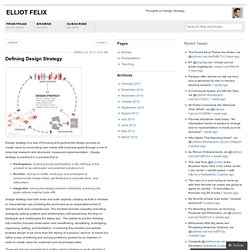
Design strategy is practiced in a process that is: Participatory: enabling broad participation in the defining of the problem to be addressed and potential solutions to itIterative: relying on drafts, mock-ups, and prototypes to communicate design ideas, get feedback to evaluate them, and refine themIntegrative: solving the design problem holistically, achieving the goals without making trade-offs Design strategy has both inner and outer aspects, existing as both a mindset or characteristic way of seeing the world and as an associated toolkit of relevant skills and competencies.
The mindset includes empathy, tolerating ambiguity, seeing systems and relationships, self-awareness, thriving on feedback, and challenging the status quo. Strategy by Design. It's remarkable how often business strategy, the purpose of which is to direct action toward a desired outcome, leads to just the opposite: stasis and confusion.
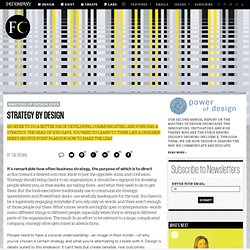
Strategy should bring clarity to an organization; it should be a signpost for showing people where you, as their leader, are taking them--and what they need to do to get there. But the tools executives traditionally use to communicate strategy--spreadsheets and PowerPoint decks--are woefully inadequate for the task. You have to be a supremely engaging storyteller if you rely only on words, and there aren't enough of those people out there. What's more, words are highly open to interpretation--words mean different things to different people, especially when they're sitting in different parts of the organization. The result: In an effort to be relevant to a large, complicated company, strategy often gets mired in abstractions. If Steve Ballmer Ran Apple. Bear with me, I know my premise is ridiculous.

Imagine Steve Ballmer was right now the CEO of Apple, with the same set of products and opportunities. Suspend disbelief about cultural clashes, or organizational structure. Presume Ballmer could set the strategy, and that Apple would execute it accordingly. In this scenario Apple would make more money in the next five years than they will under Tim Cook. At this point, I’ve fully backed off of last week’s post and believe the iPhone 5C will cost (at least) $450 (I’ll explain why soon); Ballmer, however, would push out the low cost version I advocated and attack non-subsidized markets.
Trend 4 - Design as Strategy - Five Innovative Trends I Learned From the Future. Design Quality and Customer Delight as Sustainable Advantages. Wednesday, 9 October 2013 I’ve been thinking about this piece by Ben Thompson, “What Clayton Christensen Got Wrong in His Theory of Low-End Disruption”, since he published it two weeks ago.
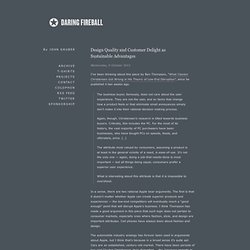
The business buyer, famously, does not care about the user experience. They are not the user, and so items that change how a product feels or that eliminate small annoyances simply don’t make it into their rational decision making process. Again, though, Christensen’s research is tilted towards business buyers. Critically, this includes the PC. In a sense, there are two rational Apple bear arguments. The automobile industry analogy has forever been used in arguments about Apple, but I think that’s because in a broad sense it’s quite apt.
Thompson really puts this well: The issue I have with this analysis of vertical integration — and this is exactly what I was taught at business school — is that the only considered costs are financial. How do you quantify delight? So the irony here is that iOS vs. CH Workshop - resonance_blog - We spent the last century sorting out supply - how to make things.
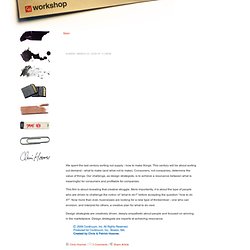
So you Wanna be a Design Strategist? (Part 1) Once every two months or so I have the pleasure of chatting it up with Bryan Zmijewski during breakfast.

So you Wanna be a Design Strategist? (Part 2) In part two of our So you Wanna be a Design Strategist?
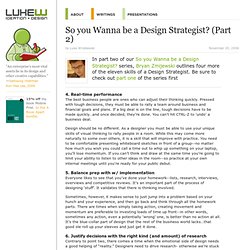
Series, Bryan Zmijewski outlines four more of the eleven skills of a Design Strategist. Be sure to check out part one of the series first 4. Real-time performance The best business people are ones who can adjust their thinking quickly.